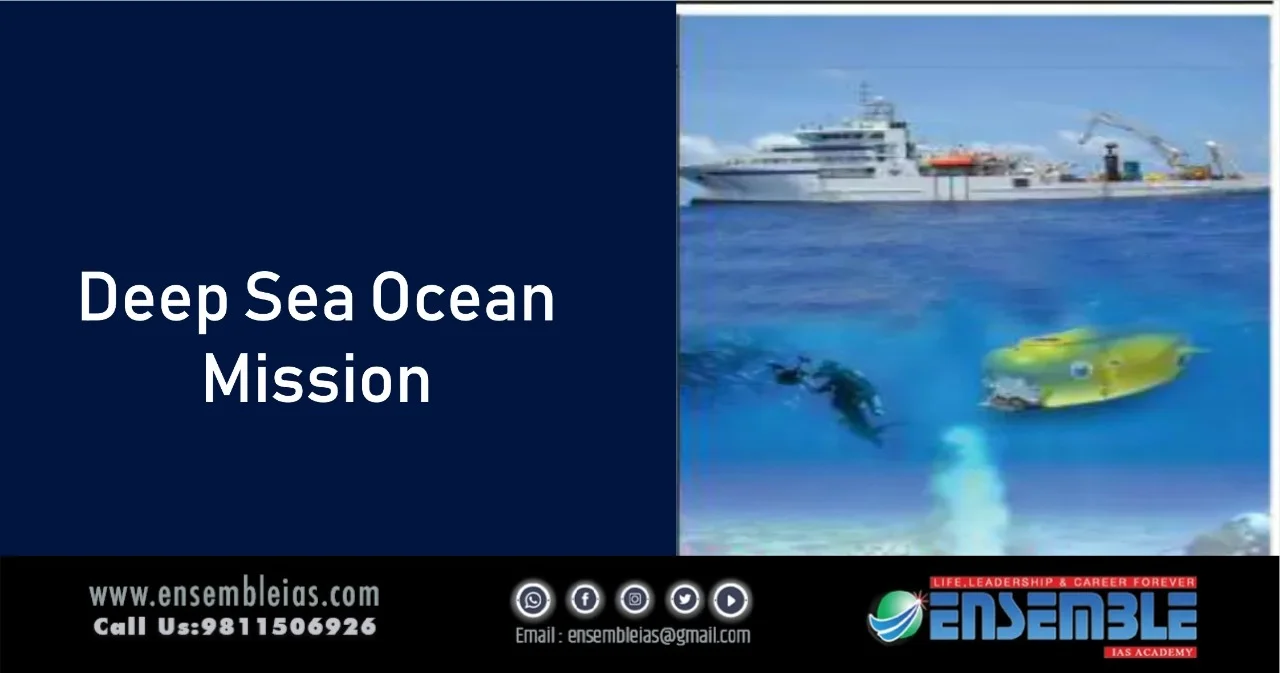DEEP SEA OCEAN MISSION
Recently, the Cabinet Committee on Economic Affairs has approved the proposal of the Ministry of Earth Sciences (MoES) on the Deep Ocean Mission (DOM). The blueprint of the DOM to explore the deep recesses of the ocean was unveiled in 2018. Earlier, MoES had also rolled out the draft Blue Economy Policy.

To buy our online courses: Click Here
The technology and expertise needed in such missions is now available with only five countries – US, Russia, France, Japan and China. India will now be the sixth country to have it.
Major Components:
Development of Technologies for Deep Sea Mining, and Manned Submersible:
- A manned submersible will be developed to carry three people to a depth of 6,000 meters in the ocean with a suite of scientific sensors and tools.
- An Integrated Mining System will be also developed for mining polymetallic nodules at those depths in the central Indian Ocean. Polymetallic nodules are rocks scattered on the seabed containing iron, manganese, nickel, and cobalt. The exploration studies of minerals will pave the way for commercial exploitation soon, as, and when commercial exploitation code is evolved by the International Seabed Authority, United Nations (UN) organization.
Development of Ocean Climate Change Advisory Services:
It entails developing a suite of observations and models to understand and provide future projections of important climate variables on seasonal to decadal time scales.
Technological Innovations for Exploration and Conservation of Deep-sea Biodiversity:
Bioprospecting of deep-sea flora and fauna including microbes and studies on sustainable utilization of deep-sea bio-resources will be the focus.
Deep Ocean Survey and Exploration:
It will explore and identify potential sites of multi-metal Hydrothermal Sulphides mineralization along the Indian Ocean mid-oceanic ridges.
Energy and Freshwater from the Ocean:
Studies and detailed engineering design for offshore Ocean Thermal Energy Conversion (OTEC) powered desalination plants are envisaged. OTEC is a technology which uses ocean temperature differences from the surface to depths lower than 1,000 meters, to extract energy.
Advanced Marine Station for Ocean Biology:
It is aimed at the development of human capacity and enterprise in ocean biology and engineering.
It will translate research into industrial application and product development through on-site business incubator facilities.
OTHER SIGNIFICANCE: CHINESE ANGLE
China’s is increasingly expanding its geopolitical reach in Asia and beyond by the use of trade and military with an ostensible aim of controlling the entire resources of South China Sea, its deep seas. along with its trade routes. China not only has a hold over Hambantota port (Sri Lanka), which is just a few hundred miles off the shores of India. China is supplying military equipment to India’s neighbours such as submarines to Myanmar, frigate to Sri Lanka, equipment to Bangladesh and Thailand, thus, in a way, colonising the region.
For India to tackle Chinese dominance in deep sea exploration, REE and in South China Sea, not only that India needs to have a maritime alliance with QUAD but also share the know-how related with anti- submarine activities, develop. the infrastructure to deploy more and larger warships and explore the entire maritime domain with a different intent, different technology, different strategy, and different approach altogether. It is a necessity for India to control maritime waters and develop multidimensional technologies for making its presence felt in maritime domain.
Also Read: What is Flag Satyagraha ?
WHY IN INDIAN OCEAN:
- TRADING ROUTES: Gyrostatically, three-quarters of the world-wide maritime trade and half of the world’s oil supplies pass through its waters. Chokepoints such as the Malacca Strait in the east and the Hormuz and the Bab el Mandeb straits in the west make much of that shipping exposed in case of military conflict. The Oceans as the last frontier of mankind, offers enough resources to guard against any potential threat in the future.
- RESOURCES: Three main types of deep-sea mineral deposits are being targeted for mining: cobalt-rich crusts usually found on seamounts, seafloor massive sulphides on hydrothermal vents, and polymetallic nodules that occur over huge plains in the deep sea. It is here you find rare earth metals and high value minerals that are overgrown by entire biological communities. The number of potential compounds obtained from marine organisms now exceed 28,000, and hundreds are being discovered every year.
- According to the latest Global Marine Biotechnology Industry Report, this field will have a global market size of USD 5.4 billion by the year 2027. In March 2020, Report Ocean stated that “the global biotechnology market is estimated to reach USD 741 billion by 2026”, pretty high compared to the forecasted market size for seabed mining, which is estimated as USD 7 billion.
- The ocean is literally a pool of viral material, where they dominate other microbes such as bacteria and archaea, thereby significantly influencing the geochemical cycles of our planet. An exceptional biodiversity exists in the oceans. Food resources such as Kelp and Krill the best known source of protein abound in Indian Ocean waters.
